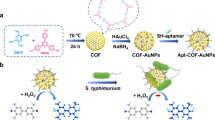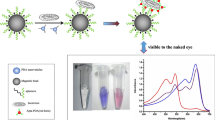Abstract
Aldehyde dehydrogenase (ALDH) was first developed as an enzymatic signaling system of a biosensor for sensitive point-of-care detection of pathogenic bacteria. ALDH and specific aptamers to Salmonella typhimurium (S. typhimurium), as organic components, were embedded in organic-inorganic nanocomposites as a biosensor signal label, integrating the functions of signal amplification and target recognition. The biosensing mechanism is based on the fact that ALDH can catalyze rapid oxidation of acetaldehyde into acetic acid, resulting in pH change with portable pH meter readout. The altered pH exhibited a linear relationship with the logarithm of S. typhimurium from 102 to 108 CFU/mL and detection limit of 46 CFU/mL. Thus, the proposed biosensor has potential application in the diagnosis of pathogenic bacteria.




Similar content being viewed by others
References
Tang L, Li J. Plasmon-based colorimetric nanosensors for ultrasensitive molecular diagnostics. ACS Sens. 2017;2(7):857–75. https://doi.org/10.1021/acssensors.7b00282.
Wongkaew N, Simsek M, Griesche C, Baeumner AJ. Functional nanomaterials and nanostructures enhancing electrochemical biosensors and lab-on-a-chip performances: recent progress, applications, and future perspective. Chem Rev. 2019;119(1):120–94. https://doi.org/10.1021/acs.chemrev.8b00172.
Wang X, Yan C, Wang X, Zhao X, Shi C, Ma C. Integrated silica membrane-based nucleic acid purification, amplification, and visualization platform for low-cost, rapid detection of foodborne pathogens. Anal Bioanal Chem. 2020. https://doi.org/10.1007/s00216-020-02823-1.
Hofmann C, Kaiser B, Maerkl S, Duerkop A, Baeumner AJ. Cationic liposomes for generic signal amplification strategies in bioassays. Anal Bioanal Chem. 2020;412(14):3383–93. https://doi.org/10.1007/s00216-020-02612-w.
Liu D, Wang J, Wu L, Huang Y, Zhang Y, Zhu M, et al. Trends in miniaturized biosensors for point-of-care testing. TrAC Trends Anal Chem. 2020;122:115701. https://doi.org/10.1016/j.trac.2019.115701.
Lisi F, Peterson JR, Gooding JJ. The application of personal glucose meters as universal point-of-care diagnostic tools. Biosens Bioelectron. 2020;148:111835. https://doi.org/10.1016/j.bios.2019.111835.
Liu D, Tian T, Chen X, Lei Z, Song Y, Shi Y, et al. Gas-generating reactions for point-of-care testing. Analyst. 2018;143(6):1294–304. https://doi.org/10.1039/c8an00011e.
Zhang Z, Wang Q, Han L, Du S, Yu H, Zhang H. Rapid and sensitive detection of Salmonella typhimurium based on the photothermal effect of magnetic nanomaterials. Sens Actuators B Chem. 2018;268:188–94. https://doi.org/10.1016/j.snb.2018.04.043.
Bu SJ, Wang KY, Bai HS, Leng Y, Ju CJ, Wang CY, et al. Immunoassay for pathogenic bacteria using platinum nanoparticles and a hand-held hydrogen detector as transducer. Application to the detection of Escherichia coli O157:H7. Mikrochim Acta. 2019;186(5):296. https://doi.org/10.1007/s00604-019-3409-6.
Li Y, Afrasiabi R, Fathi F, Wang N, Xiang C, Love R, et al. Impedance based detection of pathogenic E. coli O157:H7 using a ferrocene-antimicrobial peptide modified biosensor. Biosens Bioelectron. 2014;58:193–9. https://doi.org/10.1016/j.bios.2014.02.045.
Hassan AR, de la Escosura-Muniz A, Merkoci A. Highly sensitive and rapid determination of Escherichia coli O157:H7 in minced beef and water using electrocatalytic gold nanoparticle tags. Biosens Bioelectron. 2015;67:511–5. https://doi.org/10.1016/j.bios.2014.09.019.
Vashist SK, Luppa PB, Yeo LY, Ozcan A, Luong JHT. Emerging technologies for next-generation point-of-care testing. Trends Biotechnol. 2015;33(11):692–705. https://doi.org/10.1016/j.tibtech.2015.09.001.
Vashist SK, Mudanyali O, Schneider EM, Zengerle R, Ozcan A. Cellphone-based devices for bioanalytical sciences. Anal Bioanal Chem. 2014;406(14):3263–77. https://doi.org/10.1007/s00216-013-7473-1.
Xiang Y, Lu Y. Using personal glucose meters and functional DNA sensors to quantify a variety of analytical targets. Nat Chem. 2011;3(9):697–703. https://doi.org/10.1038/nchem.1092.
Yan L, Zhu Z, Zou Y, Huang Y, Liu D, Jia S, et al. Target-responsive “sweet” hydrogel with glucometer readout for portable and quantitative detection of non-glucose targets. J Am Chem Soc. 2013;135(10):3748–51. https://doi.org/10.1021/ja3114714.
Ahn JK, Kim HY, Park KS, Park HG. A personal glucose meter for label-free and washing-free biomolecular detection. Anal Chem. 2018;90(19):11340–3. https://doi.org/10.1021/acs.analchem.8b02014.
Chavali R, Gunda NSK, Naicker S, Mitra S. Detection of Escherichia coli in potable water using personal glucose meters. Anal Methods. 2014;6. https://doi.org/10.1039/C4AY01249F.
Mousty C, Kaftan O, Prevot V, Forano C. Alkaline phosphatase biosensors based on layered double hydroxides matrices: role of LDH composition. Sens Actuators B Chem. 2008;133(2):442–8. https://doi.org/10.1016/j.snb.2008.03.001.
Song Y, Zhang Y, Bernard PE, Reuben JM, Ueno NT, Arlinghaus RB, et al. Multiplexed volumetric bar-chart chip for point-of-care diagnostics. Nat Commun. 2012;3:1283. https://doi.org/10.1038/ncomms2292.
Wang KY, Bu SJ, Ju CJ, Han Y, Ma CY, Liu WS, et al. Disposable syringe-based visual immunotest for pathogenic bacteria based on the catalase mimicking activity of platinum nanoparticle-concanavalin a hybrid nanoflowers. Mikrochim Acta. 2019;186(2):57. https://doi.org/10.1007/s00604-018-3133-7.
Ding E, Hai J, Li T, Wu J, Chen F, Wen Y, et al. Efficient hydrogen-generation CuO/Co3O4 heterojunction nanofibers for sensitive detection of cancer cells by portable pressure meter. Anal Chem. 2017;89(15):8140–7. https://doi.org/10.1021/acs.analchem.7b01951.
Bu S, Wang K, Ju C, Han Y, Li Z, Du P, et al. A pregnancy test strip for detection of pathogenic bacteria by using concanavalin A-human chorionic gonadotropin-Cu3(PO4)2 hybrid nanoflowers, magnetic separation, and smartphone readout. Mikrochim Acta. 2018;185(10):464. https://doi.org/10.1007/s00604-018-2968-2.
Du S, Wang Y, Liu Z, Xu Z, Zhang H. A portable immune-thermometer assay based on the photothermal effect of graphene oxides for the rapid detection of Salmonella typhimurium. Biosens Bioelectron. 2019;144:111670. https://doi.org/10.1016/j.bios.2019.111670.
Han X, Lin S, Li Y, Cheng C, Han X. Near-infrared photothermal immunoassay for pancreatic cancer biomarker CA 19-9 on a digital thermometer. Anal Chim Acta. 2020;1098:117–24. https://doi.org/10.1016/j.aca.2019.11.027.
Wang J, Zhang S, Dai H, Zheng H, Hong Z, Lin Y. Dual-readout immunosensor constructed based on brilliant photoelectrochemical and photothermal effect of polymer dots for sensitive detection of sialic acid. Biosens Bioelectron. 2019;142:111567. https://doi.org/10.1016/j.bios.2019.111567.
Kwon D, Joo J, Lee S, Jeon S. Facile and sensitive method for detecting cardiac markers using ubiquitous pH meters. Anal Chem. 2013;85(24):12134–7. https://doi.org/10.1021/ac403329w.
Zhao M, Wang P, Guo Y, Wang L, Luo F, Qiu B, et al. Detection of aflatoxin B1 in food samples based on target-responsive aptamer-cross-linked hydrogel using a handheld pH meter as readout. Talanta. 2018;176:34–9. https://doi.org/10.1016/j.talanta.2017.08.006.
Zhang Y, Yang J, Nie J, Yang J, Gao D, Zhang L, et al. Enhanced ELISA using a handheld pH meter and enzyme-coated microparticles for the portable, sensitive detection of proteins. Chem Commun (Camb). 2016;52(17):3474–7. https://doi.org/10.1039/c5cc09852a.
Chen J, Xue H, Chen Q, Lin Y, Tang D, Zheng J. Enzyme-conjugated hybridization chain reaction for magneto-controlled immunoassay of squamous cell carcinoma antigen with pH meter. Chin Chem Lett. 2019;30(9):1631–4. https://doi.org/10.1016/j.cclet.2019.03.045.
Xie S, Yuan Y, Song Y, Zhuo Y, Li T, Chai Y, et al. Using the ubiquitous pH meter combined with a loop mediated isothermal amplification method for facile and sensitive detection of Nosema bombycis genomic DNA PTP1. Chem Commun (Camb). 2014;50(100):15932–5. https://doi.org/10.1039/c4cc06449f.
Ye R, Zhu C, Song Y, Lu Q, Ge X, Yang X, et al. Bioinspired synthesis of all-in-one organic-inorganic hybrid nanoflowers combined with a handheld pH meter for on-site detection of food pathogen. Small. 2016;12(23):3094–100. https://doi.org/10.1002/smll.201600273.
Wang L, Chen C, Huang H, Huang D, Luo F, Qiu B, et al. Sensitive detection of telomerase activity in cancer cells using portable pH meter as readout. Biosens Bioelectron. 2018;121:153–8. https://doi.org/10.1016/j.bios.2018.08.069.
Younus H, Arsalan A, Alam MF. Arsenic inhibits human salivary aldehyde dehydrogenase: mechanism and a population-based study. Chemosphere. 2020;243:125358. https://doi.org/10.1016/j.chemosphere.2019.125358.
Xu X, Chai S, Wang P, Zhang C, Yang Y, Yang Y, et al. Aldehyde dehydrogenases and cancer stem cells. Cancer Lett. 2015;369(1):50–7. https://doi.org/10.1016/j.canlet.2015.08.018.
Avramescu A, Noguer T, Avramescu M, Marty J-L. Screen-printed biosensors for the control of wine quality based on lactate and acetaldehyde determination. Anal Chim Acta. 2002;458(1):203–13. https://doi.org/10.1016/S0003-2670(01)01580-X.
Iitani K, Chien PJ, Suzuki T, Toma K, Arakawa T, Iwasaki Y, et al. Improved sensitivity of acetaldehyde biosensor by detecting ADH reverse reaction-mediated NADH fluoro-quenching for wine evaluation. ACS Sens. 2017;2(7):940–6. https://doi.org/10.1021/acssensors.7b00184.
Mitsubayashi K, Matsunaga H, Nishio G, Toda S, Nakanishi Y. Bioelectronic sniffers for ethanol and acetaldehyde in breath air after drinking. Biosens Bioelectron. 2005;20(8):1573–9. https://doi.org/10.1016/j.bios.2004.08.007.
Mitsubayashi K, Matsunaga H, Nishio G, Toda S, Nakanishi Y, Saito H, et al. Bio-sniffer sticks for breath analysis after drinking. Sens Actuators B Chem. 2005;108(1):660–4. https://doi.org/10.1016/j.snb.2004.11.093.
Liu Y, Zhao C, Zhao W, Zhang H, Yao S, Shi Y, et al. Multi-functional MnO2-doped Fe3O4 nanoparticles as an artificial enzyme for the colorimetric detection of bacteria. Anal Bioanal Chem. 2020;412(13):3135–40. https://doi.org/10.1007/s00216-020-02563-2.
Zhu J, Wen M, Wen W, Du D, Zhang X, Wang S, et al. Recent progress in biosensors based on organic-inorganic hybrid nanoflowers. Biosens Bioelectron. 2018;120:175–87. https://doi.org/10.1016/j.bios.2018.08.058.
Ye R, Zhu C, Song Y, Lu Q, Ge X, Yang X, et al. One-pot bioinspired synthesis of all-inclusive protein-protein nanoflowers for point-of-care bioassay: detection of E. coli O157:H7 from milk. Nanoscale. 2016;8(45):18980–6. https://doi.org/10.1039/c6nr06870g.
Bai H, Bu S, Wang C, Ma C, Li Z, Hao Z, et al. Sandwich immunoassay based on antimicrobial peptide-mediated nanocomposite pair for determination of Escherichia coli O157:H7 using personal glucose meter as readout. Mikrochim Acta. 2020;187(4):220. https://doi.org/10.1007/s00604-020-4200-4.
Dwivedi HP, Smiley RD, Jaykus LA. Selection of DNA aptamers for capture and detection of Salmonella Typhimurium using a whole-cell SELEX approach in conjunction with cell sorting. Appl Microbiol Biotechnol. 2013;97(8):3677–86. https://doi.org/10.1007/s00253-013-4766-4.
Li Y, Wu H, Su Z. Enzyme-based hybrid nanoflowers with high performances for biocatalytic, biomedical, and environmental applications. Coord Chem Rev. 2020;416:213342. https://doi.org/10.1016/j.ccr.2020.213342.
Silva NFD, Magalhães JMCS, Freire C, Delerue-Matos C. Electrochemical biosensors for Salmonella: state of the art and challenges in food safety assessment. Biosens Bioelectron. 2018;99:667–82. https://doi.org/10.1016/j.bios.2017.08.019.
Eijkelkamp JM, Aarts HJM, van der Fels-Klerx HJ. Suitability of rapid detection methods for Salmonella in poultry slaughterhouses. Food Anal Methods. 2009;2(1):1–13. https://doi.org/10.1007/s12161-008-9040-5.
Funding
This work was financially supported by the National Key Research and Development Program of China (No. 2016YFD0501001).
Author information
Authors and Affiliations
Corresponding authors
Ethics declarations
Conflict of interest
The authors declare that they have no competing interests.
Additional information
Publisher’s note
Springer Nature remains neutral with regard to jurisdictional claims in published maps and institutional affiliations.
Electronic supplementary material
ESM 1
(PDF 385 kb)
Rights and permissions
About this article
Cite this article
Zhang, W., Bu, S., Bai, H. et al. A sensitive biosensor for determination of pathogenic bacteria using aldehyde dehydrogenase signaling system. Anal Bioanal Chem 412, 7955–7962 (2020). https://doi.org/10.1007/s00216-020-02928-7
Received:
Revised:
Accepted:
Published:
Issue Date:
DOI: https://doi.org/10.1007/s00216-020-02928-7




